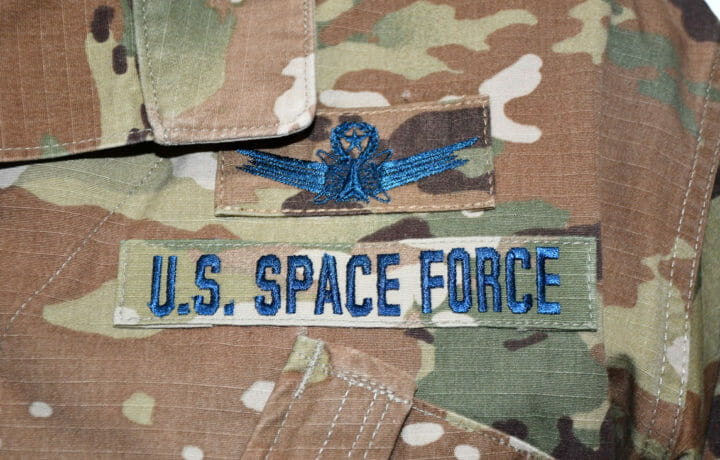Since its official “launch” at the end of 2019, the sixth and newest branch of the United States military – the United States Space Force – has also remained the smallest of the services. However, the independent military service that was signed into law on Dec. 20, 2019, has seen its ranks steadily grow.
As of the beginning of the year, the Space Force had slightly more than 6,500 uniformed “guardians” in its ranks, along with an equal number of civilian employees – each charged with operating and protecting the U.S. military’s satellites and supporting systems.
The Space Force recently expanded in size again, as more than a dozen satellites along with a United States Navy unit that operated them were transferred earlier this month. The Naval Satellite Operations Center became the 10th Space Operations Squadron on June 6, and that marked the first of several space-focused units that will see a transfer from the Army or Navy to the Space Force – which operates as a separate and distinct branch of the armed services.
It is organized under the Department of the Air Force, much like the United States Marine Corps is organized under the Department of the Navy.
A New Beginning for 10th SOPS
Formerly known as the Naval Satellite Operations Center (NAVSOC), it was first stood up in 1962 as the Navy Astronautics Groups and operated the Navy’s satellites, which provided global narrowband communications. It was the first military space operations command in history, and the united commanded TRANSIT, the world’s first satellite navigation system. Navy Astronautics Group was redesignated as NAVSOC in June 1990.
As of June 6, the unit officially became the 10th Space Operations Squadron (10 SOPS), but its mission will remain largely unchanged.
“For 60 years, NAVSOC has advocated and advanced American maritime superiority,” said Vice Adm. Ross A. Myers, commander of U.S. Fleet Cyber Command and the 10th Fleet, during the historic Disestablishment and Assumption of Command Ceremony.
“NAVSOC enabled satellite communications to afford the United States and her allies the crucial ability to provide defensive measures, conduct over-the-horizon monitoring and targeting, and project combat power in areas of conflict and instability around the globe,” Myers added.
According to Space Delta 8, the new unit is intentionally numbered the 10th Space Operations Squadron to pay honor to its heritage under U.S. 10th Fleet.
“Space has become highly contested,” Col. Matthew Holston, commander of Space Delta 8, said during the transfer ceremony. “Our adversaries recognize our reliance on space, and they are actively seeking ways to create vulnerabilities to take away our competitive advantage. It is the 10th Space Force Operations Squadron that is on the front lines to guaranteeing our American way of life.”
More Transfers Coming
Additional transfers – a process that had begun practically as soon as the Space Force was stood up in December 2019 – are still planned. It was last September that the Space Force announced that a list of 15 Army and Navy units would make the transfer.
“We’re one team with our sister services and over the last year-and-a-half we have worked with the Army and the Navy and the Air Force to determine which capabilities come over to the Space Force,” said Space Force Gen. John W. “Jay” Raymond last September when the transfers were announced.
The U.S. Army will eventually transfer roughly $78 million of operations, maintenance and manpower authorizations. That will include five wideband SATCOM operations centers, and four regional SATCOM support centers. It will also affect about 500 manpower authorizations.
It was also announced that from the Navy, its narrow band satellite constellation will transfer 76 manpower authorizations to the Space Force, as well as 13 satellites — a mix of the new multi-user objective system and the UHF follow-on satellite constellation. All told, 15 global units with 319 military and 259 civilian billets from the Army and Navy combined will eventually transfer to the Space Force.
Those transfers were originally planned to begin at the beginning of Fiscal Year 2022 (FY22), but Congress faced a delay in passing the new budget, which has slowed the process.
Interservice Transfer Program
In addition to the units that are being transferred, the Space Force also announced this month that it is accepting Fiscal Year 2023 (FY23) Interservice Transfer Program (IST) applications from June 15–30, 2022. The IST allows qualified individuals from the other Uniformed Services to apply for transfer to active-duty in the Space Force to fill select career fields.
In order to be eligible, all applicants must meet the eligibility criteria in AFMAN 36-2032, Military Recruiting and Accessions. The Space Force is accepting applications from active duty officers and enlisted personnel serving in the U.S. Air Force, Army, Navy, and Marine Corps.
All specialty codes can apply; however, the Space Force added that the transferee must be able to fill the select specialty codes in the Space Force, while a sister service release is also an essential part of the transfer process.


